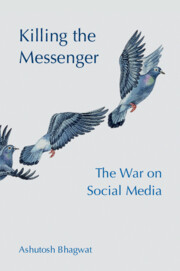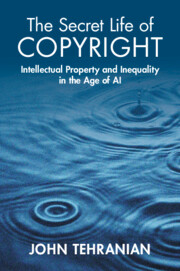Refine search
Actions for selected content:
234 results
1 - The Conservative War
-
- Book:
- Killing the Messenger
- Published online:
- 05 September 2025
- Print publication:
- 25 September 2025, pp 9-25
-
- Chapter
-
- You have access
- Open access
- HTML
- Export citation

Killing the Messenger
- The War on Social Media
-
- Published online:
- 05 September 2025
- Print publication:
- 25 September 2025
-
- Book
-
- You have access
- Open access
- Export citation
11 - Sex and Sexuality
-
-
- Book:
- The Cambridge Companion to James Joyce
- Published online:
- 14 August 2025
- Print publication:
- 21 August 2025, pp 184-199
-
- Chapter
- Export citation
4 - ©ensored
-
- Book:
- The Secret Life of Copyright
- Published online:
- 08 August 2025
- Print publication:
- 14 August 2025, pp 140-170
-
- Chapter
- Export citation

The Secret Life of Copyright
- Intellectual Property and Inequality in the Age of AI
-
- Published online:
- 08 August 2025
- Print publication:
- 14 August 2025
11 - The Limits of All-under-Heaven
- from Text 11 - Subordinating Non-Chinese
-
-
- Book:
- Chinese Statecraft
- Published online:
- 17 July 2025
- Print publication:
- 31 July 2025, pp 178-192
-
- Chapter
- Export citation
Chapter 15 - The Strange Case of a “Lost” Dramatic Performance
- from Part IV - Transcreating
-
-
- Book:
- Latinx Literature in Transition, 1444–1886
- Published online:
- 06 August 2025
- Print publication:
- 17 July 2025, pp 341-362
-
- Chapter
- Export citation
6 - Branding Birth Control
-
- Book:
- Selling Sexual Knowledge
- Published online:
- 24 June 2025
- Print publication:
- 10 July 2025, pp 181-212
-
- Chapter
-
- You have access
- Open access
- HTML
- Export citation
Chapter 10 - Gender and Sexuality
- from Part II - Social Contexts
-
-
- Book:
- Sean O'Casey in Context
- Published online:
- 23 June 2025
- Print publication:
- 10 July 2025, pp 110-119
-
- Chapter
- Export citation
Conclusion
-
- Book:
- Selling Sexual Knowledge
- Published online:
- 24 June 2025
- Print publication:
- 10 July 2025, pp 244-249
-
- Chapter
-
- You have access
- Open access
- HTML
- Export citation
Subversion of publishing comes to a boil: is it time to lance it?
-
- Journal:
- The British Journal of Psychiatry / Volume 227 / Issue 2 / August 2025
- Published online by Cambridge University Press:
- 08 July 2025, pp. 517-518
- Print publication:
- August 2025
-
- Article
-
- You have access
- HTML
- Export citation

Selling Sexual Knowledge
- Medical Publishing and Obscenity in Victorian Britain
-
- Published online:
- 24 June 2025
- Print publication:
- 10 July 2025
-
- Book
-
- You have access
- Open access
- Export citation
Chapter 2 - Consulars between the Second Punic War and Sulla’s Dictatorship (201–82)
-
- Book:
- The Role of Ex-Consuls in Republican Rome, 218–31 BCE
- Published online:
- 01 May 2025
- Print publication:
- 15 May 2025, pp 50-136
-
- Chapter
- Export citation
Chapter 1 - Facing Up to the Crisis
-
- Book:
- The Role of Ex-Consuls in Republican Rome, 218–31 BCE
- Published online:
- 01 May 2025
- Print publication:
- 15 May 2025, pp 1-49
-
- Chapter
- Export citation
Introduction
-
- Book:
- The Strange History of Samuel Pepys's Diary
- Published online:
- 24 April 2025
- Print publication:
- 24 April 2025, pp 1-14
-
- Chapter
- Export citation
Chapter 4 - First Publication
-
- Book:
- The Strange History of Samuel Pepys's Diary
- Published online:
- 24 April 2025
- Print publication:
- 24 April 2025, pp 64-83
-
- Chapter
- Export citation
Afterword
-
- Book:
- The Strange History of Samuel Pepys's Diary
- Published online:
- 24 April 2025
- Print publication:
- 24 April 2025, pp 177-183
-
- Chapter
- Export citation
Chapter 7 - ‘Every Last Obscenity’: Complete and Online
-
- Book:
- The Strange History of Samuel Pepys's Diary
- Published online:
- 24 April 2025
- Print publication:
- 24 April 2025, pp 131-150
-
- Chapter
- Export citation
13 - Multilayered Mechanisms of Control and Censorship of Arts and Culture in the Islamic Republic of Iran
-
-
- Book:
- The Rule of Law in the Islamic Republic of Iran
- Published online:
- 10 April 2025
- Print publication:
- 17 April 2025, pp 386-413
-
- Chapter
- Export citation
23 - The Papacy and Printing, 1464–1633
- from Part IV - Education, Culture, Arts
-
-
- Book:
- The Cambridge History of the Papacy
- Published online:
- 28 February 2025
- Print publication:
- 20 March 2025, pp 656-680
-
- Chapter
- Export citation
